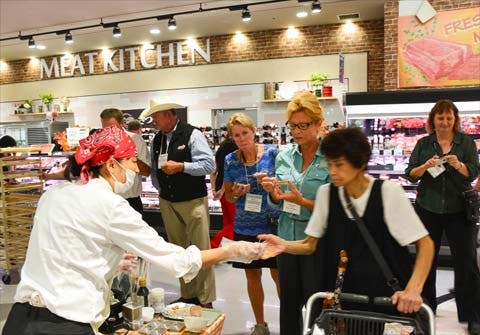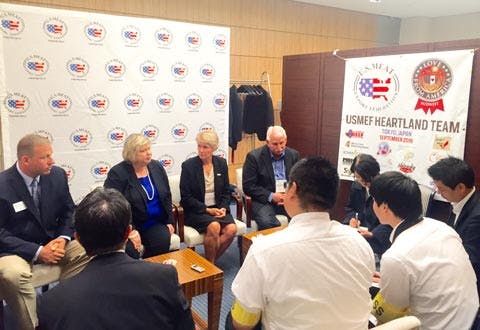Producers See Opportunities for Further Growth in Japanese Market
USMEF led a group of U.S. beef, pork, corn and soybean producers across Tokyo this week to meet with Japanese buyers, explore market opportunities and see U.S. beef and pork promotions in action. Along with touring retail food stores and meat packing facilities, the Heartland Team met with major Japanese food importers and distributors.

Members of the USMEF Heartland Team experience a product tasting at a Tokyo retail store
Team members also learned how Japanese consumers value the connection between the food they eat and where it comes from. Face-to-face meetings with Japan’s food trade media provided them with an opportunity to reach out to Japanese consumers and explain the care with which they produce livestock and grain.
“When the Japanese people are buying a product, a cut of pork or beef for example, they are attracted to the story of where it came from and who raised that hog or steer,” said Jolene Riessen, a member of the Heartland Team who grows corn and soybeans and operates a cattle feedlot in Ida Grove, Iowa, while also serving on the Iowa Corn Growers Ag Animal and Environment Committee. “And once they taste that cut of meat, they kind of connect that taste to the story behind the cut. It’s very personal for them. That’s why our group being in Japan with USMEF is important – as American farmers, we are able to put a face on the pork and beef products that they are getting from us and at the same time getting to know our stories.”
Retail visits in and around Tokyo gave the Heartland Team insight on how U.S. pork and beef are marketed to Japanese people shopping for cuts of meat to cook at home.
Jan Archer, a Goldsboro, North Carolina, pork producer and president of the National Pork Board, said she was impressed with how U.S. pork is merchandised – not only in the traditional sense but also the way USMEF and the U.S. red meat industry are creating demand for larger cuts and items that were not always promoted to Japanese consumers in the past.
“At retail, things are definitely merchandised for Japanese tastes, so these days there is growing interest in displaying American-style cuts, which tend to be larger cuts that will be barbecued,” explained Archer. “That’s different than the thinly sliced cuts that traditionally had been marketed in Japan. So it’s been interesting to see how the market is changing and how people are reacting positively to the changes.”
Riessen noted how the U.S. pork and beef products were displayed and how, with encouragement from USMEF, Japanese retailers had come up with ways to educate consumers.
“For example, stores had U.S. pork items in a tray with a recipe included at the bottom of the tray,” said Riessen, a first-time visitor to Japan. “It is a great idea as it gives the consumer an idea of how to cook the product. The Japanese people are always willing to try something different and they thoroughly enjoy their food.”
To compliment the retail tours, USMEF took the Heartland Team to the Tokyo Meat Market to observe a Wagyu carcass auction. The team also toured Nihon Butsuryu, Japan’s largest cold storage facility, where a large portion of the country’s imported red meat is held. There, members of the team were able to compare U.S. beef and pork with competitors’ brands.
“One thing we noticed during the cold storage visit was that there is far more U.S. beef in storage today than there was a year ago, and that’s a real positive and demonstrates to me that more U.S. beef is coming into Japan,” said Chris Abbott, a rancher from Gordon, Nebraska, and director of the Nebraska Beef Council, who was part of a U.S. team that visited Japan in 2015. “From what I saw and heard this week, I feel very strongly that the U.S. will push ahead of some of the competition when it comes to beef exports to Japan. We just have to continue to hold our ground in the market.”

Heartland Team members answer questions about their farms and production practices during a face-to-face session with the Japanese media
A meeting at USMEF’s Tokyo office included U.S. packer representatives from Tyson, National, Cargill, JBS and Smithfield. The Heartland Team also met with Starzen, the Marubeni Corp., Sumisho Foods and officials with the Royal Host restaurant chain.
Discussions with further processors made it clear to the team that pork for further processing is a very important import item for the Japanese food industry.
“It’s been fascinating to learn more about that portion of our export business,” said Archer. “We’ve had the opportunity to visit packing plants to get to see not only how the product is brought in to the country, but also what happens after that. It is especially interesting to see how those large muscle cuts of U.S. pork – for example, loins – are prepared for further processing.”
Having face-to-face conversations with each aspect of the Japanese market reminded the Heartland Team that competition for shares of the red meat market is fierce. The team credited USMEF with working hard to keep U.S. red meat at the forefront.
“I’ve been impressed with USMEF’s staff in Japan, they are really in touch with what is happening in the market,” said Michael Korth, a grain and cattle producer from Randolph, Nebraska, who serves on the United Soybean Board. “To be here in person and see where we are at in the market, and how the people working on our behalf have gotten us to this point, is really encouraging.”
Still, there is a lot of work to be done in order to grow protect and expand the U.S. meat industry’s share of this fiercely competitive market, the team learned.
“The cold reality is that we’ve lost some market share – last year’s west coast port slowdown impacted us negatively, as well as Japan’s inability to get affordable product when we were suffering from porcine epidemic diarrhea virus,” said Archer. “We are facing competition from the European Union and Canada, and increasing competition from Mexico, so we are going to have to bring our ‘A’ game and make sure we are bringing value to that market. USMEF has done a tremendous job maintaining those relationships so that we have a way we can communicate the quality of our product. We are up for the fight and that’s our plan – we are going to fight to get this business back.”
The Heartland Team’s Japan visit concluded Friday with a U.S. Red Meat Trade Seminar and Tasting Session, which attracted more than 700 buyers, distributors and other meat industry professionals to the Tokyo Prince Hotel.
Jan Archer, president of the National Pork Board, speaks during the U.S. Meat Trade Seminar & Tasting Session in Tokyo
Other members of the Heartland Team are:
- Joe Baldwin of Indiana Pork
- Leonard “Butch” Brown of the Michigan Beef Industry Commission
- Joni Bucher of the Illinois Beef Association
- Craig Converse and Timothy Ostrem of the South Dakota Soybean Research and Promotion Council
- Nathan Dorn, Anne Meis, Robert Rasmussen and Ron Stech of the Nebraska Soybean Board
- Patricia Dumoulin of the Illinois Corn Marketing Board
- Gary Porter of the Missouri Corn Merchandising Council
- Bradley Schad of the Missouri Corn Growers Association
- Rebecca Nepple of the National Pork Board and
- Will Wise of the Oregon Beef Council
